Special Feature: Products Sally Recommends
Why Go To Goa?
The miles of golden sand beaches, crystal clear water and brilliant green landscape would be enough to satisfy the most particular tourist. But add the interesting history of Goa, the smallest state in India, and you have a truly exotic destination.
After weeks of hot and dusty travels through colourful Rajasthan, the refreshing sea breeze of the Goan coastline is doubly welcome. The beach was our first priority but then we decided to explore further and look at the Portuguese-influenced local scene.
Most of the historical interest is evident in the many religious buildings built by the Portuguese when they arrived in the 16th century, and in the old colonial homesteads which document the lives of these early settlers.
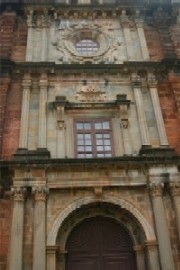 I am standing in the Basilica of Bom Jesus, the huge, stately home to the remains of one of the most important Christian Saints, St Francis Xavier (1506 – 1552). In May 1542 at the age of 36, the young priest was sent to Goa by Portugese King Dom Joao III. While working in Goa, he converted over 30,000 people to Catholicism, then moved on to travel all over Asia. He died in China but his body was eventually enshrined in this Cathedral, and is paraded through the town of Goa every decade or so. When this happened at the end of 2004, a crowd exceeding two million people arrived from all over the world to make this one of the largest gatherings in Asia.
I am standing in the Basilica of Bom Jesus, the huge, stately home to the remains of one of the most important Christian Saints, St Francis Xavier (1506 – 1552). In May 1542 at the age of 36, the young priest was sent to Goa by Portugese King Dom Joao III. While working in Goa, he converted over 30,000 people to Catholicism, then moved on to travel all over Asia. He died in China but his body was eventually enshrined in this Cathedral, and is paraded through the town of Goa every decade or so. When this happened at the end of 2004, a crowd exceeding two million people arrived from all over the world to make this one of the largest gatherings in Asia.
Looking at the silver-and-glass coffin, I cannot help thinking of the huge influence this man had on the Catholic world. Churches everywhere are named after him, schools are dedicated to him, and his fame even extends to Indian-Christians, Hindus, and Muslims, who know him as Goencho Sahib. He is reputed -- even among non-Christians – to have miraculous healing powers and to have the ability to bring good fortune. And in many parts of India he has become the patron-Saint of Cars and Trucks, a little strange for someone who actually lived in the 16th Century and brought the Inquisition to Asia.
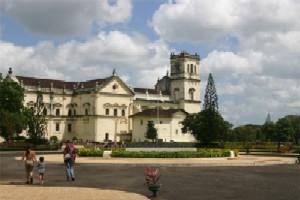 This Cathedral, built by Jesuits in 1594, is awesome in size and stature, and incorporates a three-tiered-façade that combines Doric, Ionic, and Composite styles. But wait a minute! Are my eyes playing tricks, or do the cherubs around the state of St Ignatius and The Holy Infant have a distinctly Indian look? That’s Goa! A combination of Portugese Catholicism, Indian traditions, and a total devotion to St Francis Xavier.
This Cathedral, built by Jesuits in 1594, is awesome in size and stature, and incorporates a three-tiered-façade that combines Doric, Ionic, and Composite styles. But wait a minute! Are my eyes playing tricks, or do the cherubs around the state of St Ignatius and The Holy Infant have a distinctly Indian look? That’s Goa! A combination of Portugese Catholicism, Indian traditions, and a total devotion to St Francis Xavier.
Later, on a stroll through the town, it’s obvious that the primary contribution of the Portuguese was in the form of Baptisms and Church-building. When they finally left places they had ruled, British or French colonialists left behind a legacy of law, government, civil service, and a vast numbers of wide, tree-lined avenues with (usually) stately buildings. The Portuguese, by contrast, did not leave very much more than a proliferation of Churches and Portuguese family names – as their system of colonizing was to send male settlers and encourage them to marry locals.
This little enclave of Portuguese culture in Asia, supported by one of the richest iron-ore deposits in the world, was a sleepy colonial backwater until 1961 when, after 400 years of Portuguese rule, Goa was forcibly annexed by India.
When the Portuguese moved out, the hippies moved in. The climate was balmy, pot was cheap, and the locals needed every dollar this new wave of international visitors brought in, even though that genre of new-age tourist-backpackers were not renowned as big spenders.
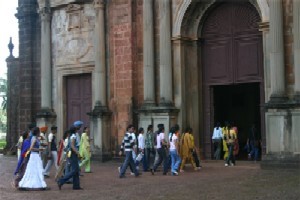 Goa has different attractions for everyone. The warm climate, un-crowded beaches, a unique Portuguese heritage of Iberian flavors and lifestyles mixed with those of India, all make Goa an appealing destination. There are three main streams of visitors – Pilgrims coming to see St Francis Xavier’s last resting place, young people attracted to the lazy lifestyle and, more recently, knowledgeable tourists visiting India. This group often uses Goa as a final stop and resting-up hideaway, perfect after a usually-hectic tour of India’s major attractions.
Goa has different attractions for everyone. The warm climate, un-crowded beaches, a unique Portuguese heritage of Iberian flavors and lifestyles mixed with those of India, all make Goa an appealing destination. There are three main streams of visitors – Pilgrims coming to see St Francis Xavier’s last resting place, young people attracted to the lazy lifestyle and, more recently, knowledgeable tourists visiting India. This group often uses Goa as a final stop and resting-up hideaway, perfect after a usually-hectic tour of India’s major attractions.
The locals are friendly and will go out of their way to help you. The food is an interesting combination of southern Indian spices and Portuguese flavours. Like in all other tropical destinations, it’s wise to only drink bottled water or water that has been boiled for tea.
So what is there to see in Goa? A good place to start is Old Goa and a local guide is the best way to do this. Your hotel concierge can help you find someone who knows the ‘real Goa’ and its history.
OLD GOA
Don’t expect a whole lot of public colonial buildings that tell the story of Goa’s history in the way that some do in places like Mumbai (Bombay), Yangon (Rangoon), or Delhi. In Goa it’s mainly churches and cathedrals but if you are interested in history as influenced by the spread of religion, you will find it fascinating.
Start with the church of St Cajetan, its architecture inspired by St Peters in Rome. Alongside this is a College of Theology that is still operating to this day. Then move to Se Cathedral in Senate Square, a truly magnificent building, thirty meters (90 feet high) with a 76 metre (249-ft) central knave featuring 15 altars and superb interior chapels and fittings. To the west of this stands the Church of St Francis Assisi, a particular attraction of which is the carved doorway and the floral frescoes. Next visit the Church and Monastery of St Augustine, which at one time was the largest church in India. Built in 1512, it was abandoned in 1835 when the townspeople moved and had disintegrated to the point where its glory was only rediscovered when excavations started in 1989 and revealed tombstones, a library, and other parts of its formidable history. The Church of Our Lady of The Rosary and the Church of Our Lady Of the Mount may also be of interest if you haven’t suffered from Church-architecture-indigestion by this time.
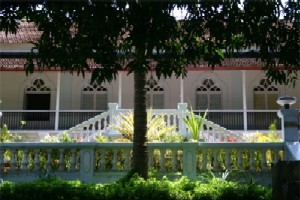 Of particular interest to culture and history lovers is a visit to Goa’s colonial mansions. Many of the Portuguese trading families became extremely wealthy and built superb homes, developing an architecture that is a cross between India and Portugal. Ask your guide to take you to ‘Sat Burnzam Gor’ (7 Gables) in nearby Margao. Here panels of oyster shells replace glass windows to keep out Goa’s summer heat.
Of particular interest to culture and history lovers is a visit to Goa’s colonial mansions. Many of the Portuguese trading families became extremely wealthy and built superb homes, developing an architecture that is a cross between India and Portugal. Ask your guide to take you to ‘Sat Burnzam Gor’ (7 Gables) in nearby Margao. Here panels of oyster shells replace glass windows to keep out Goa’s summer heat.
Braganza House in Chandor is a particularly rewarding place to visit and is arguably the most stately of all of Goa’s colonial mansions. It is still occupied by members of the family that built and owned it, but if your Concierge phones ahead, you will probably be allowed a small private inspection. Please leave a donation for maintenance.
An insiders tip. In one of Goa’s old Colonial houses at Chogm Road, Sangolda, you will find what is arguably the most fascinating antique shop in Goa. You can spend hours here, without any pressure to buy, and take a break at the small coffee shop that is part of the establishment. But it is a very strong-willed person that can come away from here having bought nothing. Superb fabrics, antique colonial and Portuguese furniture, Goan household items, and decorator pieces that will make wonderful dinner-table conversation when you get home, abound here.
There are also a couple of modest museums in Goa -- the State Museum in Patto and the Archeological Museum converted from the Convent of St Francis of Assisi, and located alongside the Church. You might also like to visit some of the local Portuguese forts. Fort Aguada, Chapora Fort, and Terekhol Fort will add to your understanding of the early Portuguese period.
Old Goa was the hub of Portuguese Colonialism, but the constant epidemics and consequent ill-health of its inhabitants forced a move to Panaji, nearby – but less swampy. This is a friendly, leafy town with a new commercial hub and was the official capital of Portuguese territories in India.
SO ARE CHURCHES AND FORTS THE MAIN REASON TO GO TO GOA?
No! Goa’s charm and attraction is actually as a place to totally unwind and relax.
There are plenty of good hotels in Goa, but we found two that are arguably head and shoulders above the average. The first is the Park Hyatt, built in the style of a traditional Portuguese-Goan village. Being the top of the line in the Hyatt hierarchy – there are very few places allowed to carry the Park Hyatt logo – you expect something very exotic and lavish, but what really makes the Park Hyatt stand out is its staff. Having traveled all over India we found this resort-hotel to have the best-trained and most user-friendly staff of any place we have stayed at in this country. You could not get a better and more welcoming ‘home-away-from-home’. And the Sereno Spa, the largest in the area and spread across 28,000 square feet is a perfect place to relax after a hot day’s sightseeing.
 Conde Nast Traveler Magazine rated this 46-acre resort as one of the 100 Best New Hotels World-wide in 2004 and we totally agree with their judgment. The cuisine here is also outstanding, with a South-Indian restaurant, a grill, an Italian Trattoria, a Wine & Cigar Bar, and The ‘Aquamarine’ pool-side bar. If you want an outstanding breakaway with unbelievable service, the Goa Park Hyatt is a hard act to beat.
Conde Nast Traveler Magazine rated this 46-acre resort as one of the 100 Best New Hotels World-wide in 2004 and we totally agree with their judgment. The cuisine here is also outstanding, with a South-Indian restaurant, a grill, an Italian Trattoria, a Wine & Cigar Bar, and The ‘Aquamarine’ pool-side bar. If you want an outstanding breakaway with unbelievable service, the Goa Park Hyatt is a hard act to beat.
The other luxury hotel, very small and very exclusive, is the Nilaya Hermitage, an elegant hilltop hotel to which regular European ‘Movers-and-Shakers’ are drawn to each year. This is not a place for wild parties or a vast range of external activities. 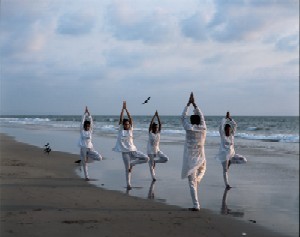 This amazing hotel is owned by an Indian businessman and his charming German-born wife, and has to be seen to be believed. Rooms are lavish, imaginative, and furnished with exotic astrological details. To supplement the Indian gourmet cuisine prepared by the resident chef, the owners fly a European chef in from France every year. A large swimming pool, a tennis court, and an Ayurvedic Massage Center, Gym, and Steam Bath add to the relaxed ambiance of this small exquisite hotel.
This amazing hotel is owned by an Indian businessman and his charming German-born wife, and has to be seen to be believed. Rooms are lavish, imaginative, and furnished with exotic astrological details. To supplement the Indian gourmet cuisine prepared by the resident chef, the owners fly a European chef in from France every year. A large swimming pool, a tennis court, and an Ayurvedic Massage Center, Gym, and Steam Bath add to the relaxed ambiance of this small exquisite hotel.
So if India in on your ‘must go’ list, consider finishing your tour with a ‘rest-and-relaxation’ stop in Goa. It will be the perfect finale for your trip.
For more information on the two hotels mentioned…
http://www.nilayahermitage.com/
Note: This information was accurate when it was published. Please be sure to confirm all rates and details directly with the businesses in question before making your plans.



